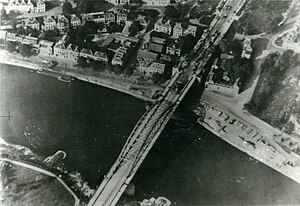Battle of Arnhem
| Battle of Arnhem | |||||||
|---|---|---|---|---|---|---|---|
| Part of Operation Market Garden | |||||||
 Aerial reconnaissance photo of the Arnhem road bridge taken by the Royal Air Force on 19 September, showing signs of the British defence on the northern ramp and the wrecked German vehicles from the previous day's fighting. |
|||||||
|
|||||||
| Belligerents | |||||||
|
|
|
||||||
| Commanders and leaders | |||||||
|
|
|
||||||
| Strength | |||||||
| 1 reinforced airborne division 1 parachute infantry brigade RAF Resupply flights Limited support from XXX Corps in later stages |
*Initially equivalent to: 1 Kampfgruppe 1 armoured division |
||||||
| Casualties and losses | |||||||
|
#Approx 1,984 killed 6,854 captured |
#Approx 1,300 killed 2,000 wounded |
||||||
|
*More details of the German strength can be found in the 'German forces' section #More detailed information is available in the 'losses' sections |
|||||||
The Battle of Arnhem was a major battle of the Second World War fought in and around the Dutch towns of Arnhem, Oosterbeek, Wolfheze, Driel and the surrounding countryside from 17–26 September 1944.
After sweeping through France and Belgium in the summer of 1944, after the Battle of Normandy, the Allies were poised to enter the Netherlands. Field Marshal Sir Bernard Montgomery, commanding the Anglo-Canadian 21st Army Group, favoured a single thrust north over the branches of the Lower Rhine River, allowing the British Second Army to bypass the Siegfried Line and attack the Ruhr. To this end, the Allies launched Operation Market Garden on 17 September 1944. Allied Airborne troops were dropped in the Netherlands to secure key bridges and towns along the Allied axis of advance. Farthest north, the British 1st Airborne Division, supported by men of the Glider Pilot Regiment and the 1st Polish Parachute Brigade, landed at Arnhem to secure bridges across the Nederrijn. Initially expecting a walkover, British XXX Corps planned to reach the British airborne forces within two to three days.
...
Wikipedia
